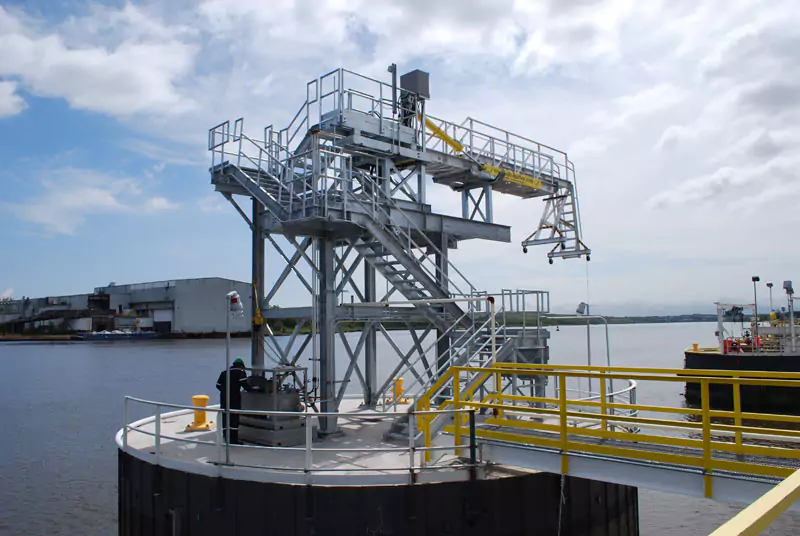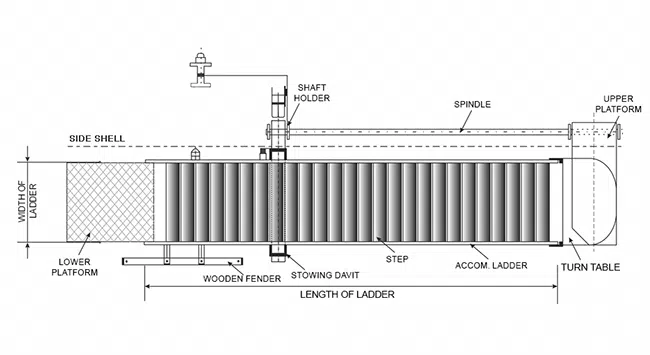The Ultimate Guide to Gangway Ladder Maintenance: Tips and Best Practices

Introduction
Maintaining gangway ladders is vital for the safety and efficiency of offshore operations. Proper upkeep reduces the risk of accidents, extends the lifespan of the equipment, and ensures compliance with industry regulations.
This guide will cover essential inspection tips, cleaning and lubrication methods, and advanced maintenance practices to keep your gangway ladders in top condition. By following these best practices, readers can learn how to improve the safety, performance, and longevity of their gangway ladders.

1: Understanding Gangway Ladders
- Telescopic Gangway Ladders:
Extendable and retractable ladders that adjust to various ship-to-shore heights. Ideal for flexible docking conditions.
- Folding Gangway Ladders:
These ladders can be folded for compact storage when not in use, making them perfect for vessels with limited space.
- Fixed Gangway Ladders:
Permanently installed ladders designed for frequent and consistent access, typically on docks or fixed points on larger vessels.
- Articulating Gangway Ladders:
Feature hinged sections to adapt to varying angles or tides. Often used for dynamic docking environments.
- Portable Gangway Ladders:
Lightweight and easy to move, these ladders can be temporarily placed where needed for boarding or maintenance tasks.
- Suspended Gangway Ladders:
Attached to the side of a vessel, typically with davits or cranes. Often used for quick boarding or emergency situations.
- Hydraulic Gangway Ladders:
Equipped with hydraulic systems
Common Uses in Offshore Environments
Gangway ladders are essential for safe access between vessels, platforms, and shore facilities. They are used in industries like oil and gas, shipping, and marine research for transferring crew members, supplies, and equipment.
Importance of Regular Maintenance
Routine maintenance is critical to ensure reliability and longevity. It minimizes downtime, prevents sudden failures, and reduces repair costs.
2: Routine Inspection Tips
Daily Inspection Checklist
- Visible Damage or Wear: Look for cracks, dents, or other signs of damage.
- Bolts and Screws: Ensure all fasteners are secure.
- Stability Check: Confirm that the ladder is stable and securely fastened.
Weekly and Monthly Inspection Routines
- Corrosion or Rust: Inspect joints and hinges for rust, which can weaken the structure.
- Deformation or Misalignment: Check for bends or misaligned sections.
- Functionality of Moving Parts: Ensure hinges and locks operate smoothly.
Signs of Wear and Tear to Look For
- Cracks or Fractures: Serious structural issues that require immediate attention.
- Loose or Missing Components: Replace any missing or damaged parts.
Excessive Rust: Address any rust promptly to avoid further damage.
3: Cleaning and Lubrication
Best Practices for Cleaning Gangway Ladders
- Mild Detergent and Water: Use a soft-bristle brush to clean without damaging the material.
- Thorough Rinsing: Rinse with fresh water to remove cleaning agents.
- Complete Drying: Prevent rust by drying the ladder thoroughly before storage.
Lubrication Tips for Moving Parts
- Marine-Grade Lubricant: Use high-quality lubricants to protect against rust.
- Application to Hinges and Joints: Ensure all moving parts are lubricated for smooth operation.
- Wipe Away Excess Lubricant: Remove excess to avoid attracting dirt and debris
4: Common Maintenance Issues and Solutions
Addressing Corrosion and Rust
- Rust Removal: Use a wire brush or sandpaper to remove rust.
- Rust Converter or Primer: Apply to prevent further corrosion.
- Marine-Grade Paint: Coat the ladder to protect it from future rust.
Repairing Damaged Components
- Replacing Damaged Parts: Install new bolts or screws as needed.
- Welding or Replacing Cracked Sections: Repair cracks or replace damaged sections to ensure safety.
Preventative Measures to Avoid Common Issues
- Regular Inspections: Catch small issues before they become major problems.
- Protective Coatings: Apply anti-corrosion coatings to extend lifespan.
- Proper Storage: Store ladders in dry, covered areas when not in use.
5: Safety Considerations
Safety Protocols During Maintenance
- Manufacturer Guidelines: Follow all recommended maintenance procedures.
- Proper Lifting Techniques: Avoid injuries by using correct lifting methods.
- Secure the Ladder: Ensure the ladder is stable before any inspection or maintenance.
Personal Protective Equipment (PPE) Requirements
- Gloves, Safety Glasses, and Hard Hat: Protect against common maintenance hazards.
- Harness or Safety Belt: Use when working at heights to prevent falls.
- Good Condition PPE: Ensure all PPE is undamaged and properly fitted.
Ensuring Compliance with Industry Standards
- Regulatory Guidelines: Stay up-to-date with industry requirements.
- Regular Safety Audits: Conduct audits to identify and resolve safety concerns.
- Training: Keep all staff informed on the latest safety practices.
6: Advanced Maintenance Techniques
Using Specialized Tools and Equipment
- High-Quality Maintenance Tools: Ensure effective and reliable maintenance with the right tools.
- Specialized Cleaning Equipment: Use appropriate tools to clean and lubricate effectively.
Professional Maintenance Services
- Certified Professionals: Regular inspections by experts can ensure thorough maintenance.
- Complex Repairs: Hire professionals for repairs beyond your team’s expertise.
- Maintenance Contracts: Consider ongoing contracts for regular, reliable service.
When to Consider Replacement
- Extensive Damage: Replace ladders that are beyond safe repair.
- Cost-Effectiveness: If repairs are too frequent or expensive, replacement may be more economical.
- Changes in Standards: Replace ladders to comply with updated industry regulations.
Conclusion
Maintaining gangway ladders is essential for safe, efficient offshore operations. By implementing regular inspections, cleaning, and advanced maintenance practices, you can extend the lifespan of your ladders while minimizing risks and downtime. Prioritize safety, follow manufacturer guidelines, and stay updated on industry standards for optimal performance.
Need Help Maintaining Your Gangway Ladder? We’re Here to Assist!
At Vesselex, we know how essential a well-maintained gangway ladder is for safe and efficient offshore operations. If you’re facing any issues or need expert guidance on maintenance, we’re here to help. Our team specializes in:
✅ Professional Guidance on proper gangway ladder maintenance to enhance durability and performance
✅ Regular Inspections & Servicing to prevent failures and ensure compliance with safety standards
✅ Repair & Component Replacement for worn-out, damaged, or corroded parts to keep your ladder reliableIf you want to keep your gangway ladder in top condition, get in touch with us today!
We’re always here to assist—just drop us a message or give us a call!


